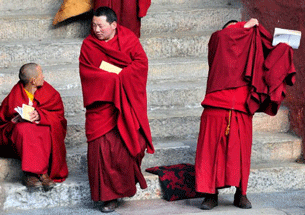China behind Siang river in Arunachal Pradesh drying up?
By Kaushik Deka, Mail Today: On March 1, when Oyen Moyang, 48, came to see his farmland on the bank of the Siang at 21 Miles in Pasighat in Arunachal Pradesh, he got the shock of his life. The mighty river had dried out. Nearby was standing a dejected fisherman Gorakh Sahani. Thirty-year-old Sahani has learnt only one thing all his life - catching fishes. As he was staring at the vast stretch of sand and stones on the Siang, he wondered: "What will I do next? Is it time to return to my native Motihari in Bihar?"China is believed to be building dams on the Siang, known as the Yarlung Tasngpo in Tibet.
Moyang was once told by his relative Tako Dabi - now the spokesperson of the Arunachal Pradesh government and advisor to Chief Minister Nabam Tuki - that China was building dams on the Siang, known as the Yarlung Tasngpo in Tibet, and these dams would change the course of the river.
The memories of the June 9, 2000, flood in Pasighat were still fresh in Moyang's mind. On that day, the water level of Siang rose suddenly by 30m, inundating almost the entire town. He had never seen such a catastrophe. He later got to know that it was the result of the collapse of a hydropower dam in Tibet.
"I read in newspapers about China's plan to divert the waters of Siang. A dry Siang convinced me that something was wrong on the upper reaches of the river. So I called up Dabi," Moyang, a post-graduate in history, said.
That phone call made global news as Dabi, who himself inspected the driedup riverbed, went public
suggesting that China's dam on the Yarlung Tsangpo could have stopped water from reaching Arunachal Pradesh. Dabi could not have chosen a better day to rake up the issue as Chinese foreign minister Yang Jiechi was in Delhi on a two-day visit. China was quick to dismiss Dabi's claim.
"To satisfy the needs of the Tibet Autonomous Region, China has begun to build a hydroelectric power station at Zangmu on the Yarlung Tsangpo. It does not have a big capacity and will not affect the downstream water regulation," China's foreign ministry spokesman Hong Lei said.
Dabi's claim found no official response in India too. The Central Water Commission, which monitors the country's river basin systems, says there is no information of any "abnormal" decline in the water level of Siang. The district commissioner of East Siang, Talem Tapok, who is a native of Pasighat, also rubbished Dabi's statements.
While Dabi could not produce any photographic evidence of the Siang drying up on March 1, he claims there is a 40 per cent drop in the flow of the the river at Pasighat town.
The Mail Today team travelled around 50km across the Siang from Pongging in upper Siang to Jampani, 23km west of Pasighat.
At Pongging, a village 28km north of Pasighat, the Yamne river meets the Siang. There were dry patches of sand and stones at the confluence of the rivers. The locals say this is not unusual during the lean period, but for the last two years these patches are increasing.
"I have no clue about China and its plan to build dams on the Siang, but the river has shrunk for the last couple of years," says Take Panyang, 25, a farmer in Pongging.
Five kilometres down at Bodak, villagers are unaware of any change in the water level. "I don't understand what this fuss is all about. The Siang is like this at this time of the year," says M. Tayeng, 52, in Bodak.
At the Ranaghat bridge in Pasighat, the river was flowing in narrow channels on a large sandy riverbed. Around 300m north of this 763.5m bridge, there used to be a ferry ghat, which operated motorboats round the year. It's all sand and stone now.
The same is the situation at Kumalighat in Pasighat, where our team saw a motorboat stuck in the sand. Around 500m west is 21 Miles, where Moyang saw the sand bed of the Siang. On March 4, when our team visited the area, seven persons crossed the river walking on a natural bridge formed by the rocks at the bottom of the river. At another point, however, there was waist-deep water. "You can now see water because it has been raining for the last three days," Jhontu Sahani, 40, a fisherman, said.
Dabi is not convinced, though. "You may find water at some points and I understand this is a lean period. But never in my life have I seen people crossing the river on foot. And what about the 2000 flood? It was surely a dam bust. The central government must take action now to stop the Chinese from diverting Siang's water. If China has not done anything, the Central Water Commission should conduct an in-depth study in collaboration with the state government to get to the crux of the problem," he said.
But with his own government not siding with him, Dabi has little chance of success.


Comments
Post a Comment